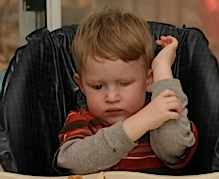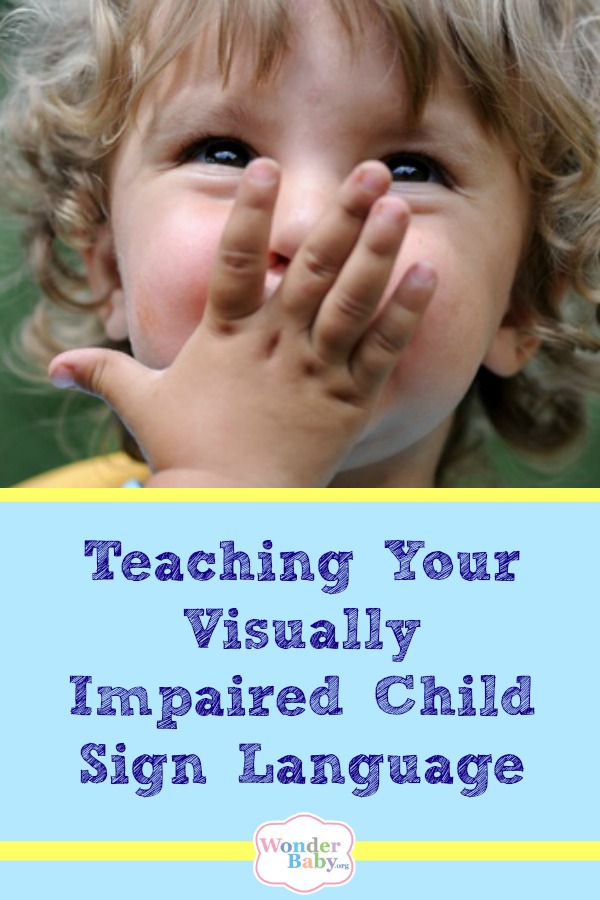Teaching Your Visually Impaired Child Sign Language

By Jennie S.
Effective communication is such a critical skill for children to learn. We all communicate in a wide variety of ways. We use spoken words, different intonations in our voice, subtle gestures (raising our eyebrows, a sly smile or a quick wink), and not so subtle gestures (waving our arms, stomping our feet or clapping our hands loudly.)
Some research studies say that over 80% of expressive communication is nonverbal. Have you ever noticed how many people move their hands while they talk? In some cultures, it seems impossible NOT to gesture while speaking!
I remember being at a conference and we all had to sit on our hands and then engage in conversation with someone sitting nearby. Within seconds, people were lifting their hands to gesture saying they simply could not keep them still while talking. Do you know anyone like that? Does this describe YOU?
For many children, especially those with disabilities, learning how to communicate effectively is extremely difficult. Using gestures and formal signs is a way to facilitate expressive language and opens doors for so many kids who, for whatever reason, simply have not yet been able to develop verbal skills. Almost all young children use gestures when learning to talk. They wave bye-bye, shake their little heads “no” and blow very wet kisses. Such actions clearly express a thought, an intention, or an emotion and all can be done without speaking.

My son, Max, who is totally blind with bilateral anophthalmia, is one of those young children who is having a very difficult time learning to use verbal language. He is three years old and has four spoken words, two of which he is just beginning to use. However, Max can communicate twenty-seven things to us today because we have taught him how to use signs (that number is sure to be higher by the time you are reading this). Without signs, Max would only be able to say “mama”, “dada”, “night-night”, and “ball”. These are all great words to have, but not a very powerful way to make his needs known throughout his day.
Getting Started
The process for Max to learn sign has been very long and persistent. If my memory serves me correctly, I think I signed three signs with him many times per day for about six months before he began to show any attempt at doing a sign by himself.
When I started introducing signs to Max, I was teaching in an intensive program for preschoolers with autism and using a strict ABA (Applied Behavior Analysis) method. This is what gave me the idea to just keep at it with Max.
The basic principle is to choose an item that is HIGHLY preferred (for him it was his “lovie bear” he sleeps with and uses for general comfort). I would say and sign “bear” EVERY time he came into contact with the bear. I took his hands and made the sign on his body two or three times and then immediately gave him the bear.
I just used natural daily opportunities to work on signs versus a structured teaching setting where you give the item and then take it back to do it over again. I think kids learn faster with natural opportunities because it has everyday context. Two other early signs for Max were “milk” and “cracker”.
10 Steps to Teaching Signs
- Choose items that are extremely preferred because they are motivating. Most of us are not going to sign for brussels sprouts!
- Start with no more than three signs. If you sign everything, it becomes overwhelming—kids will tune out and adults will lose interest.
- Find several opportunities each day to use the sign. Repetition is the key.
- Give the item or do the activity (tickle game, for example) IMMEDIATELY after making the sign. If you wait, even 30 seconds in the beginning, you are no longer reinforcing the gesture. 30 seconds is a long time and, within that time, the child has most likely done another behavior (turned his head, started to cry, waved his arms) and then you are reinforcing the wrong act of intended communication. I think I walked around my house with a bear in my pocket or within an arm’s reach for six months!
- Be consistent. If your child is going to learn the sign for “cracker” then they need to see or feel the sign every time they are in contact with a cracker.
- Always use the word with the sign. Don’t sign in silence.
- Give verbal praise after the sign is made, even if it was done with hand-over-hand facilitation. I used to give physical as well as verbal praise: “Wow Max, you asked for your bear!” along with tickles as I gave him the bear.
- Ignore pleasantries, at least at first. It’s nice if kids learn to say “please” or “sorry”, but when you have a very limited vocabulary, each sign needs to be powerful. You can add the social “nice-nice” things later.
- Accept a sign approximation as a success. Most kids are not going to motor plan the sign perfectly, especially since they cannot see you doing it. Even verbal kids will say wa-wa before water. Later you can shape the “baby signs” into perfection if this is going to be a primary means of communication. As kids learn verbal language, signs naturally drop out.
- Give it time!
Language is Power!
Using signs and gestures is language. The use of signs does not prevent children from learning to speak. Research has proven this. In fact, there are studies that show children who used signs as babies actually had more spoken words as they grew than their non-signing peers.
There are many resources for learning how to make signs. Michigan State University, for example, has created an American Sign Language Browser that plays small video clips of common signs to visually demonstrate how to make them. You can pick the words you want to teach your child and see them demonstrated right there on the spot!
If you have great strategies that you have already used to help teach your child how to sign, let us know so we can share them with others.

Related Posts

Eye Conditions and Syndromes, Visual Impairment
Neuralink Announces Plans to Restore Sight to the Blind with Brain Chip
Elon Musk’s company Neuralink has announced plans to begin human trials of its new “Blindsight” brain chip by the end of 2025.

Visual Impairment
The Gift of Understanding: How a Young Child Helps His Blind Father Navigate Life
When a parent is blind, it’s natural for people to wonder how their sighted child will adapt. Will they struggle to understand their parent’s needs? Will they feel burdened by...

Braille and Literacy, Toys, Visual Impairment
24 Braille Toys for Kids Who are Blind
Everything from alphabet blocks to raised line coloring pages and activity books to puzzles to card and board games... and so much more! And it's all in braille ready for...